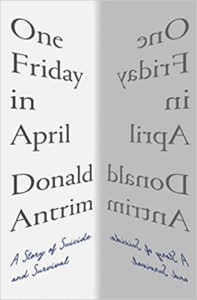Antrim breaks all the rules in this just-published memoir, achieving a result that is unique and profoundly moving, fascinating, and informative.
The story that holds it all together issues from an addled mind where reality is mixed with passion, memory, and illness. Of the classic storylines, this is a man takes a journey, or perhaps a man climbs out of a hole.
The first pages of the book find the author barely averting suicide while hanging from a fire escape on a chilly evening and the last pages find him sitting on a couch listening to his wife play the piano. Chronologically, the story begins with his birth and ends in the present day. How can a writer convey an entire life (so far) in 133 pages? Read and see. The poet Patrick Lane achieves a similar feat in his memoir, What the Stones Remember.
The book also recalls the “magical thinking” experienced by Joan Didion in her eponymous book, The Year of Magical Thinking. Only Antrim says his untethered and chaotic patterns of thought and action have lasted all his life. His suffering takes place in a subjective infinity, Hell, an eternal state of almost-death.
A cloud of confusion and pain lies over the book. If you try to pierce it, you’ll come up with another cloud, though in the end, Antrim gives the reader some ideas and a basket of compassion to hang onto.
The point of the story is Antrim’s opinion that our understanding of suicide is all wrong. He states his oppositional view in the opening aphorism: “Ask not what disease the person has, but rather, what person the disease has. (Sir William Osler)” The widow writhing in the agony of her loss need not ask “Why did he leave me?” Her attempt to make sense of it is speculation fed by myth. There was no choice involved in leaving her. Antrim writes, “As long as we see suicide as a rational act taken after rational deliberation, it will remain incomprehensible.”
Antrim quotes another memoir, Darkness Visible: A Memoir of Madness, in which William Styron “argues that the word ‘depression’ is inadequate to describe this illness…Suicide, in [Antrim’s] experience, is not that.” He repeats that it is not “an act or a choice, a decision or a wish.”
It is an illness which began long before he was hanging from a fire escape. It is a “social disease” caused by some kind of deprivation—he ruminates whether his case could have been caused by lack of touch in infancy. He makes the reasonable and logical argument that suicides don’t want to die. They are taken from us by illness, and that illness is not depression but suicide itself.
Antrim has found relief through numerous Electroconvulsive Therapy (ECT) treatments. The book is not a treatise praising ECT, but a plea to readers to realize that the people under treatment for suicidal ideation or suicide attempts, and the people already taken from us by suicide, are not “wild-eyed types,” but Everyman. Everywoman.
In its analysis and pleas for mercy, the book is a powerful statement supported by the author’s personal story and the stories of others who did not survive, such as David Foster Wallace.
Perhaps the greatest miracle of this memoir is the artistry of Antrim’s writing. The reader is in today, then yesterday, then the day before yesterday, then tomorrow, without the slightest hitch. Oh, it looks easy, but anyone who has tried it can tell you it isn’t.
Using his authorial legerdemain, he changes voice with stunning effect. Read this:
“…We went to a room down the hall. It was an operating room—lots of medical equipment, but also computers and electronics.
You lie in your gown and your socks on the table. You’re looking up at the white ceiling…”
Can you feel the stunning change from third person to second? Suddenly it’s not computers and electronics…it’s YOU lying there. This brilliant change of voice shocked and unsettled this reader.
In the last few lines, Antrim writes that while sitting on the couch listening to his wife play the piano, he is writing a letter to “you.” What the reader thought was a memoir written for the general public has been all along an intimate letter, a confession and explanation, a thing that is adamantly real and present, important to “you.”
It’s hard to stop writing about or quoting this book. This reader is left with gratitude that Antrim has not let his suicidal suffering slip into the past but has brought it to us in present detail, so we can understand and perhaps better help those people who are living in its eternal hell.
The message of the book is not that we should pity what Antrim went through, but what we all are going to do about it. He does us the grace of bringing us his call to arms through a page-turning, engrossing, tale of life and death, or death and life.
